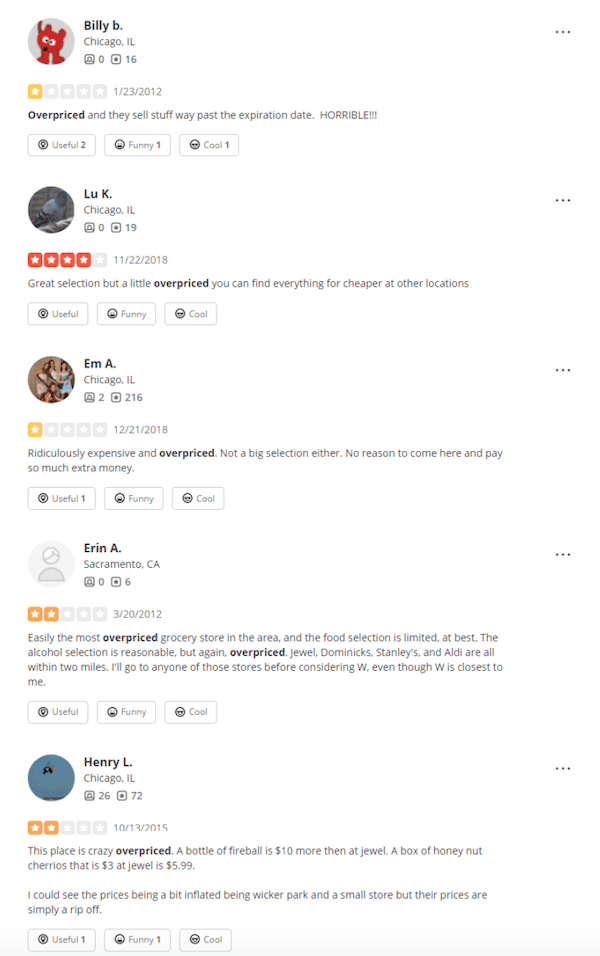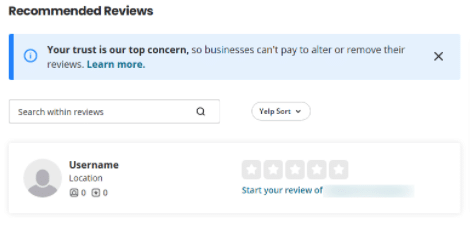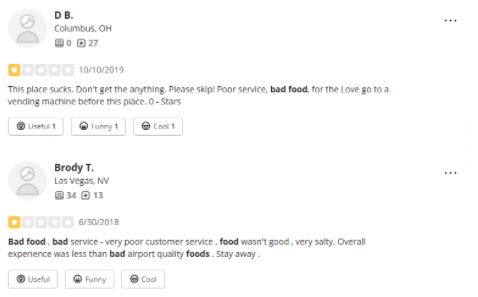They have a 1.5 rating.
This isn’t an individual review from a mean-spirited customer — these are aggregate reviews. Their poor rating isn’t due to a small number of reviews either.
As of today, they have 133 reviews on Yelp.
They have a 1.5-star rating in Google Reviews and a 5.5/10 star rating on Foursquare. Is it possible for businesses like these to come back from a reputation disaster like this?

If you can stay in business, who cares?
Why fixing your bad review portfolio is a matter of survival
It’s about lost revenue — past, present, and future.
Here’s a recap from my previous articles; research from Moz found businesses risk losing as many as:
- 21.9% of customers if you have just one negative review listed on page one of Google
- 44.1% of customers if you have two negative results
- 59.2% of customers with 3 negative results
- 69.9% of customers with 4 negative results
Want to calculate the impact this would have on your business? This post gives you the formula you can use to do just that.
As you can see, the consequences are severe.
But it’s also clear.
Your review portfolio impacts your revenue in the present and future. This means a strong review portfolio comes with significant benefits.
- A significant increase in conversions
- Increased revenue
- Lower marketing and advertising costs
- Improved customer trust
- Shorter sales cycles
Reviews are all about trustworthiness. Your customers are looking for indicators that show (a.) your business is trustworthy, (b.) your product or service performs as expected, and (c.) that you meet customer expectations. You consistently offer your customers the care, guidance, and protection they need.
Do you have what you need to deal with negative reviews?
Many brands think they do.
But the reality of the situation is that most companies approach reputation management haphazardly. They treat it as a subset of marketing, as content that goes out. They request reviews and respond to reviews, but that’s about it.
They’re reviews aren’t treated as intelligence.
They’re treated as a line item or to-do that needs to be checked off a list. Don’t misunderstand, businesses that consistently request reviews will do well.
But that’s not what we’re trying to do here.
We’re trying to rebuild a poor review portfolio and a battered reputation. There’s a significant amount of work that needs to be done if you’re going to fix bad reviews.
The first step?
Get everything you need together ahead of time to negotiate from a position of strength. The more upfront work you do, the easier it is to rebuild your reputation.
What you need:
- Tools to collect and aggregate your reviews across all review sites. You could do this manually, but it’ll dramatically increase the amount of time you’ll need to invest. The right tools will offer sentiment analysis and advanced reporting, enabling you to analyze trends from your customer’s reviews quickly.
- An outline discussing reputation governance and processes. Who’s in charge of review management? Who responds to customers? Who addresses customer complaints listed in the review? What sort of authority or spending power does your team have to address customer concerns?
- Create an employee incentive program. What can you do/offer to motivate employees, so they’re more willing to request reviews? Which employees can participate? Will these incentives be distributed publicly, in front of other employees, or privately? If you have a program that rewards outstanding employee performance, your team is more likely to meet or exceed performance expectations.
- A response policy that governs company responses to customers; which reviews do you respond to (all, positive, negative, neutral)? When will your team respond to each review? Will you provide employees with scripts and templates they can use? Are they free to speak off the cuff, or do they need to follow documentation closely? What should the tone of their responses be?
If you have all of that in place, you’re ready for the first step in the recovery process.
I’m assuming you’ve already claimed your review profiles. If you haven’t, you’ll want to make sure that your profiles are set up properly and that you can respond to customer reviews.
Step #01: Analyze your reviews to identify trends
Don’t worry, you’ll get to the individual reviews in a bit. Right now, we need to focus on identifying the most common problems mentioned in your customer reviews. For example, sentiment analysis can be used to identify trends like these:

Did you catch it?
All of these customers feel this grocery store is incredibly overpriced. These reviews give us direction and clarity; we can read customer reviews more closely to learn more about the specifics of each objection.
What about the cause of these bad reviews?
- This store is focused on the wrong target audience
- Their products or their service fail to deliver the kind of value customers feel justifies the price
- Customers don’t understand why the same product is 1/3 less somewhere else
This is why you need a tool.
Sentiment analysis tells you where to look, providing you with the direction you need for a deeper dive.

How do you use these keywords?
You use them to search through the reviews in your profile! For example, if you’re using Yelp, look for a search box that looks like this:

Let’s say we use the keyword “bad food.”
Yelp would filter reviews in your profile, so only reviews with the keywords “bad food” are visible.
So now we dig in.

Okay, you have your reviews.
What now?
Well, you need to come up with several things:
- An apology, an explanation, and the corrective steps you’ll take to resolve the problem
- An irresistible offer or incentive to motivate unhappy customers (and lurkers reading their reviews) to return
- Scripts and templates you can use to address this particular problem
- A point of contact who will receive communication from customers who take you up on your irresistible offer
- A review request campaign that requests feedback from all new customers
Take the time now, when no one’s watching, to create and test these ideas.
You’re ready for step #02.
Step # 02: Begin responding to customers
If you’re responding to negative reviews, begin with a thank you and an apology. First, thank them for taking the time to share their feedback, then provide them with the right apology.
Did you know apologies have their own language? When apologizing, people expect you to communicate:
- Regret. These customers want to hear the words “I’m sorry.” They want to see, hear and feel your remorse in your apology.
- Ownership. These customers want you to own the fact that you screwed up — without excuses, evasion, or blame.
- Restitution. These customers are looking for you to make them whole again. Maybe that’s you issuing a refund, handling an exchange, or offering a substantial discount on their next visit.
- Reform. How will you prevent this issue or problem from ever happening again? These customers want to see that you have a plan, policy, or procedure to avoid these mishaps.
- Forgiveness. These customers want you to request reconciliation. They want to see your humility and vulnerability. Some may intentionally reject you when you ask. Others may welcome you back with open arms, but they still want you to ask.
Which one is most important to your customer? You have no idea. That’s why it’s essential that you use all five of these elements in your review response to customers.
Just make sure you clear it with legal first.
Next, include your irresistible offer and your contact information in your response.
What if you can’t say sorry?
Refer to this post (and the templates inside if you feel the legalities are an issue for your business.
Step # 03: Fix the problem
Step #03 is self-explanatory.
If your customers give you a second chance, make sure you’ve done the upfront work needed to fix the problem. If you fail to address their concerns, objections, or complaints, you’ll find that the next review they leave will compound the damage done to your business.
It’s crucial that you wow them and earn their trust back.
Make your unhappy customer’s experience memorable. Go above and beyond to address the issues mentioned in their review. Roll out the red carpet, and make sure your employees are on their very best behavior. Do what you can to restore the relationship.
Step #04: Request another review
You’ve done it.
You under-promised and over-delivered; your unhappy customer is happy.
It’s time for the ask.
Reach out to these customers personally to request a review.
This requires nuance.
If you rush in for the review, it leaves a sour taste in your customer’s mouth.
That’s no good.
A better idea would be to ask customers about their experience. You ask them questions as if they’re already writing their reviews.
Here’s a shortlist of questions you can ask.
- Did we make you happy?
- I’m sorry that we let you down the first time. Do you feel we’ve made things right?
- What can we do to show you that we care?
- What can we do to restore our relationship with you?
- Do you feel taken care of?
Don’t use all of these questions all at once.
Choose one or two.
Then work them into your request template.
Here’s a comprehensive list of email templates you can customize. Use these templates to request reviews, get feedback, or earn buy-in from customers.
- 44 Unique Email Templates for Requesting Online Reviews
- 60 Review Request Text Templates To Get Google Reviews
- 61 Email Review Request Subject Line Templates
- 11 Review Response Templates For Great Reviews
- 8 Review Response Templates For Negative Reviews
Wait for customers to respond with their feedback; once you’ve confirmed that they’re happy, you make the ask.
Would you be willing to share your feedback?
If they say yes, send them a link to your review profile. This is simple and easy if you’re using review management software like Grade.us.
This four-step process seems too good to be true, but it works.
Believe it or not, customers are willing to forgive.
This is how you fix bad reviews
You begin with a thank you and I’m sorry.
As we’ve seen, your review portfolio impacts your revenue in the present and future. You’ll see significant conversion and revenue gains with a strong review portfolio. You’ll see a boost in customer trust, shorter sales cycles, and lower marketing costs.
It’s the tip of the iceberg.
Your customers are looking for indicators that show you’re trustworthy; you perform as expected and meet their expectations. Offer your customers the care, guidance, and protection they need, and you’ll find fixing bad reviews is a straightforward process.









